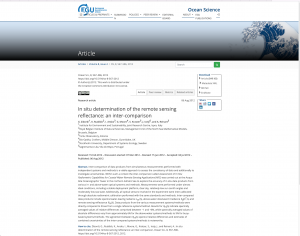MetEOC-1 partner JRC paper on inter-comparison of in situ data products for in- and above-water optical systems published in Ocean Sciences

G. Zibordi, K. Ruddick, I. Ansko, G. Moore, S. Kratzer, J. Icely, and A. Reinart of JRC had their paper In situ determination of the remote sensing reflectance: an inter-comparison published on 6 August 2012 in Ocean Sciences magazine.
Koppmann, R., F. Olschewski, P. Steffens, C. Rolf, P. Preusse, A. Ebersoldt, F. Friedl-Vallon, A. Kleinert, C. Piesch, J. Hollandt, B. Gutschwager and C. Monte of PTB and BUW presented the paper at the International Radiation Symposium this month in Berlin, Germany.
The paper summarises results from a radiometric inter-comparison performed in the northern Adriatic Sea with the main objective of evaluating the agreement of in situ spectral remote sensing reflectance products determined through the application of independent measurement systems and methods.
The Inter-comparison Assessment of In Situ Radiometric Capabilities for Coastal Water Remote Sensing Applications (ARC) was carried out at the Acqua Alta Oceanographic Tower in the northern Adriatic Sea to explore the accuracy of in situ data products from various in- and above-water optical systems and methods.
Satellite ocean colour data are applied for coastal and inland water management, including water quality monitoring, harmful algal bloom detection and sediment transport studies. How ever, confident use of these data requires the quantification of uncertainties, generally accomplished by the comparison of satellite products with in situ reference measurements. In the case of satellite ocean colour, the spectral remote sensing reflectance (Rrs) determined from top-of-atmosphere radiance is the primary data product used for the generation of higher level products such as chlorophyll a concentration (Chl a). As a consequence, access to accurate in situ Rrs is essential for the assessment of primary data products from satellite ocean color missions.
In situ Rrs data are obtained through in-water and above-water optical measurement systems. Both approaches rely on .. methods frequently tied to a variety of instruments characterised by different design and performances. Combined with diverse implementations of measurement methods, application of different processing schemes, and various sources and methods for the absolute radiometric calibration of field instruments may lead to unpredictable uncertainties affecting the assessment of satellite products.
The quantification and the successive reduction of uncertainties for in situ measurements is thus a major challenge for ocean coloor scientists actively involved in field radiometry. Basic tasks include the precise implementation and ap- plication of established measurement and analysis methods, and additionally an investigation and quantification of each source of uncertainty in primary data products. Best practice suggests the verification of each measurement and process ing step through inter-comparison exercises.